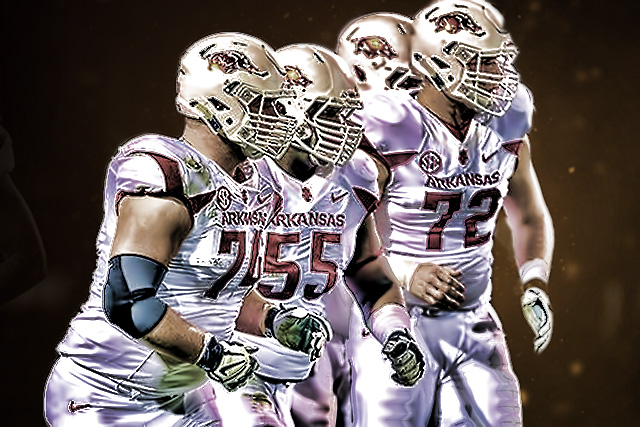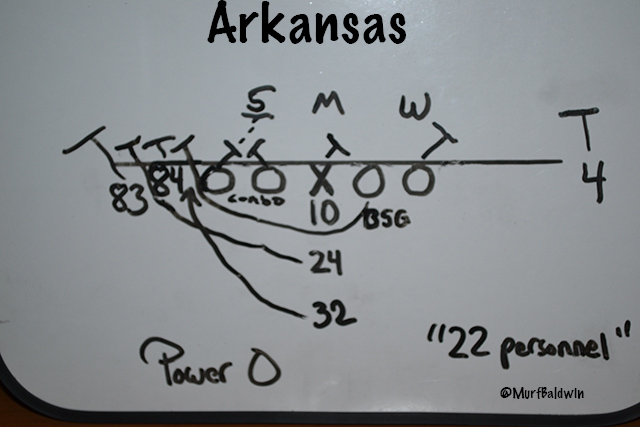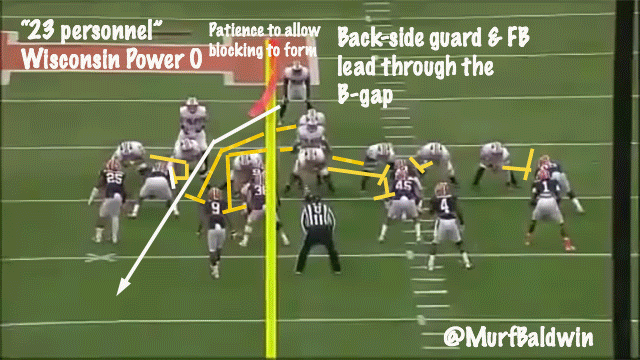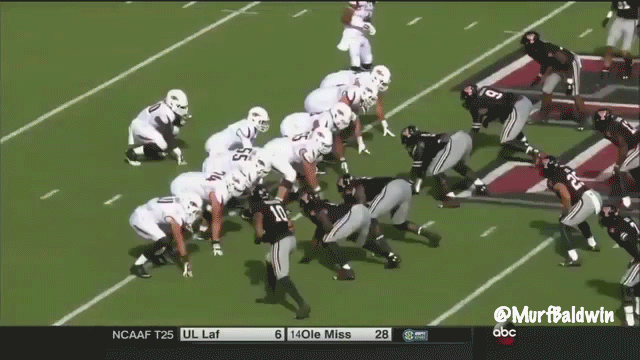Why Arkansas has the most complete run game in college football
When it comes to the combination of scheme and personnel, the University of Arkansas has the most complete running game in the nation — with much respect going to the University of Wisconsin and Stanford University.
While the lion’s share of the credit usually goes to the running backs, and rightfully so as Jonathan Williams and Alex Collins are the best duo in the nation, it’s the totality of the offensive line and the effectiveness of the tight ends that puts Arkansas in the elite of the elite.
But moreover, it’s the diversity within the rushing concepts that sets the Hogs apart.
Head coach Bret Bielema made a career out of assembling top blocking talent in his time at the University of Wisconsin: Joe Thomas (tackle), Gabe Carimi (G/T), Peter Konz (G/C), Kevin Zeitler (G), John Moffitt (G), Ricky Wagner (T), Travis Frederick (C), Ryan Groy (G), Kraig Urbik (G), Owen Daniels (Y), Lance Kendricks (Y/U) , Garrett Graham (U/Y), Jacob Pedersen (Y), Bradie Ewing (F) and now Rob Havenstein (T) all contributed to the most physical run game in the country (man, I love me some Wisconsin football).
Now in his brief tenure at Arkansas, Bielema has been around some legit blocking talent in Travis Swanson (C/G), Denver Kirkland (G/T), Dan Skipper (G/T), Sebastian Tretola (G), Frank Ragnow (G), Patrick Arinze (F), A.J. Derby (Y), Hunter Henry (Y) and Jeremy Sprinkle (Y) — with much more talent on the way.
Additionally, the move from an offensive coordinator with a spread-to-pass background (current University of Pittsburgh OC Jim Chaney), to one with a background deeply rooted in no-nonsense, shorten-your-neck-while-we-lay-you-on-the-grass-like-fertilizer smashmouth football — former Central Michigan University HC Dan Enos — only means a more multiplicative rushing attack is being brewed in the Natural State.
While a 7-6 finish to the 2014-15 season is nothing to phone home about, the arrow is certainly pointing up for Bielema and the boys when you possess the style of rushing attack, and personnel, the Razorbacks do.
Base Power Concepts
As someone who played an off-the-ball linebacker position — albeit at the semi-professional level — any rushing play with the word “Power” in front of it just sends chills down my spine (and not in a good way).
I knew that when we played a team whose rushing style was rooted in this scheme, it was time to brings an extra chinstrap and a clean set of underoos (wait, I worded that weirdly).
Teams running Power do so through a gap- or man-blocking scheme designed to isolate certain players in and around the front seven on the defense. Down blocks, combo blocks, kick-out blocks, wham blocks, trap blocks and back-side pulls, ran out of a variety of personnel groupings, are just some of the aspects that make up the best run concept in football, in my not-so-humble opinion.
Here is the most effective inside jaunt, the Power O play, ran out of “22 personnel,” diagrammed on my trusty white board — using the jersey numbers of Arkansas’ starting skill personnel.
There’s a ton of moving parts on this particular play ran to the closed side of the formation: a combo block by the play-side tackle and guard, second-level blocks, kick-out blocks by the tight ends and a pulling guard from the backside who is the linchpin of the entire operation.
In fact, the O in the name is short for the “opposite” guard; Williams is perfect for this play as he works off blocking extremely well.
This was the base play for Bielema’s outfit at Wisconsin with another back who compares favorably to “J-Will,” former Badger great Montee Ball. But if you ask Ball, it was the effectiveness of interior linemen like Frederick and Konz that shaped this neck-shortening play.
Just look at this gem of a play: The Badgers lined up in what I refer to as a “grown-man set,” “23 personnel,” and proceeded to get busy with that Power O run off the right side of the formation.
Take notice of the interior combination and down blocks as well as how physical the tight end was in springing Ball for an explosive gain.
In addition to Williams, Arkansas also has a star back who does a lot better in the power run game than I once thought in the rising junior Collins.
Additionally, Collins runs with the type of patience that doesn’t dampen his effectiveness when waiting for a couple of blocks to take shape like with this Power O. However, he has been known to get his dance on in the backfield and not hit the creases fast enough. But this sequence certainly shows he’s more than an outside runner.
This is my absolute favorite play in Arkansas’ Power arsenal — much to the chagrin of my friends in Hogville — as it’s a Power play that initially looks finesse. On this toss-dive, you get a lot of the same elements as the Power O: pull action, combo blocks, kick-out blocks and backs-side seals (check out the physical block from the “U”).
This seems to be a play virtually exclusive to Williams as I can think of quite a few times he’s run it. And the only other team I know running this particular play is Louisiana State University who is pretty diverse, conceptually, as well.
But the ferocity, athleticism and wherewithal of the offensive line and extra blocking personnel makes Arkansas the best Power teams in existence.
Power Out of Single-back Formations
To me, what makes Arkansas’ run game so difficult to defend is with its ability to go Power from alignments mostly associated with passing, also known as multiple-receiver sets.
Bielema is the king of tendency breakers: loading up in “22 personnel,” with a reduced split for a receiver and going vertical, or, jumping in “11 personnel, with the receivers in spread and running Power to the open side of the formation.
Just when you think you have an idea of what’s coming, he’ll scheme it up to where you are just utterly confused. Fans are under the belief that it’s high-powered passing teams like Texas A&M and the University of Mississippi that’s at the forefront in the creativity department, but I believe the most creative teams are the ground-centric ones that formation you to death.
Lining up in “12 personnel” with a flexed Y and reduced split for the X-receiver is tough for any defense to deal with. You have to treat it as a passing formation, but you still have blocking personnel in tow.
Here we see a guard-tackle (Kirkland, left tackle Dan Skipper) lead to the strong side of the formation equipped with a nice block from Derby who washed down the inside linebacker.
You can’t tell me there’s not beauty in this physical play.
Misdirection, Tosses, Sweeps & Y-Leads
Believe it or not, Arkansas may be even more effective in the edge-bending run game and misdirection series. This lends itself to the fact that despite the o-line being filled with players of the larger variety, they still have to be athletes to properly function in the Bielema scheme.
Additionally, Bielema only recruits tight ends and receivers who have the ability to master the nuances of the position.
Imagine being the best receiving tight end in the country — as Henry is — and acting as a lead blocker on a plethora of inside and outside plays; that’s what makes Arkansas’ run game so complete.
Check out the beauty of this counter play: you got a bit of zone action with the front-side linemen in lockstep to the back side of the play. We also saw a physical block from the tight end coming from the back side of the formation with the receiver springing the block from his reduced split.
There are a ton more concepts in Arkansas’ rushing attack — inside/outside zone, traps and whams — but in the interest of brevity I’ll get into those on another article.
However, the Hogs have mastered a slew of run concepts, and you can bet your bottom dollar that Enos is going to bring some of his own. But regardless, it’s the type of linemen, tight ends and running backs that Bielema recruits who make this rushing outfit as complete as it gets.
But keep in mind that complete doesn’t necessarily mean dominant as teams like Louisiana State University, Auburn University and the University of Georgia are certainly up for that part of the discussion. But if Arkansas does cement itself as the most dominant force in country, we may certainly see the conference turned upside down.
I wouldn’t rule out that happening as soon as this season, either.







